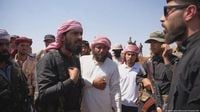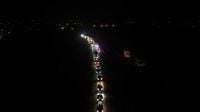Since mid-July 2025, the Syrian province of Sweida has become a volatile flashpoint, exposing the fragility of Syria's post-Assad landscape amid fierce sectarian violence involving the Druze community, Sunni Bedouin tribes, and government forces. This unrest, triggered by a seemingly isolated roadside assault on July 11, rapidly escalated into a complex conflict drawing in regional and international players, most notably Israel, which intervened militarily in a bid to protect the Druze minority.
The initial spark was a brutal attack on a Druze vegetable seller along the Damascus-Sweida highway by armed Bedouin men, an incident that quickly spiraled into tit-for-tat kidnappings and retaliatory violence. Within 48 hours, what began as local skirmishes erupted into open firefights, engulfing Sweida city and its surroundings. The Syrian Observatory for Human Rights (SOHR) reported nearly 100 fatalities by mid-July, including around 60 Druze fighters and civilians, 18 Bedouin combatants, and 14 government security personnel.
The Druze, a monotheistic religious group with roots tracing back to the 11th century, number between 800,000 and one million worldwide, with a significant population in Syria's Sweida province. Historically, the Druze have maintained a stance of neutrality in regional conflicts, focusing on protecting their community's autonomy and cultural identity. However, the overthrow of Bashar al-Assad's regime in December 2024 has left minorities like the Druze increasingly vulnerable amid rising sectarian tensions and insecurity.
In response to the escalating violence, Syria's interim government, led by President Ahmad al-Sharaa, deployed armed forces to Sweida on July 14, imposing a curfew and attempting to restore order. Yet, this move deepened divisions. While Damascus claimed to have secured permission from local Druze factions, key Druze leaders accused the government of breaching agreements and siding with the Bedouin tribes, fueling further clashes.
Amid this turmoil, Israel dramatically escalated its involvement. On July 15 and 16, the Israel Defense Forces (IDF) launched airstrikes targeting Syrian military assets, including tanks near Sweida and strategic sites in Damascus, such as the Ministry of Defense headquarters. Israeli Prime Minister Benjamin Netanyahu framed these strikes as a protective measure for the Druze community, declaring a mission to "defend the Druze and enforce a demilitarized zone" in southern Syria.
Israel's intervention was not limited to military action. Hundreds of Israeli Druze citizens from the Golan Heights crossed briefly into Syria to aid their co-religionists, while the IDF evacuated and medically treated Druze individuals and delivered humanitarian aid in Sweida. This involvement underscores the complex relationship between the Druze communities across Syria and Israel, where about 150,000 Druze live and serve prominently in the Israeli military, contrasting with the more ambivalent ties of the Druze in the Golan Heights.
The conflict's brutality was marked by grave human rights abuses on both sides. Human Rights Watch documented widespread sectarian abuse, looting, and home burnings during the clashes. Videos surfaced showing government militiamen humiliating Druze religious leaders and Druze fighters executing captured government forces. Bedouin tribal fighters were also implicated in sectarian killings and prisoner executions. This cycle of revenge and violence led to mass displacement, with nearly 80,000 Druze fleeing Sweida by mid-July, while hundreds of Bedouin families sought refuge in government-controlled areas.
The crisis in Sweida has been further complicated by a sophisticated disinformation campaign. Syrian authorities revealed that approximately 300,000 active social media accounts, including thousands of fake profiles, have been spreading divisive narratives and misinformation, exacerbating tensions and confusing public understanding of the conflict. This digital warfare has amplified sectarian divisions and influenced international perceptions, often casting the local tribal feud as a broader religious war or jihadist incursion.
Underlying the immediate violence is a deeper political struggle. The new Syrian government under al-Sharaa, who has links to Islamist factions, faces criticism for its handling of minority protections and the integration of former Assad-era security personnel into its ranks. Al-Sharaa's administration has been accused of miscalculating its authority in Sweida, believing it had tacit approval from the United States and Israel to deploy forces, a misstep that contributed to the outbreak of hostilities.
Meanwhile, Druze leader Sheikh Hikmat al-Hajari, who enjoys backing from Israel, resisted government efforts to reassert control over Sweida, instead calling for Israeli intervention. This stance complicated attempts at peace and lent credence to Israel's military actions. The Druze community itself is divided, with some leaders seeking political accommodation with Damascus, while others remain wary of government intentions.
International diplomacy has played a crucial role in de-escalation efforts. Under U.S. auspices, with support from Turkey and Jordan, a ceasefire was brokered by July 19, leading to the withdrawal of Syrian government forces from Sweida and a return of local Druze authorities to de facto control. The agreement also calls for an exchange of detainees and hostages, as both Druze militias and Bedouin tribes hold captives from the conflict.
Despite the ceasefire, the situation remains precarious. Armed Bedouin tribes continue to gather near Sweida, and mistrust lingers on all sides. The Syrian government has faced challenges in enforcing security and protecting minorities, while Israel's strikes on Syrian government institutions raise questions about sovereignty and regional stability. Additionally, the conflict has highlighted Sweida's role as a hub in Syria's Captagon drug trade, managed by figures linked to the Israel-backed al-Hajari, adding layers of criminality to the political and sectarian turmoil.
The Sweida crisis encapsulates the broader challenges facing Syria in the post-Assad era: fragmented authority, sectarian fault lines, foreign interventions, and the struggle for national unity. It underscores how local disputes can rapidly escalate into international flashpoints when external actors with competing agendas become involved. For the Druze community, spread across Syria, Lebanon, and Israel, the conflict is a stark reminder of their precarious position amid shifting regional dynamics.
As Sweida cautiously returns to calm, the road ahead is fraught with uncertainty. The fragile ceasefire offers a temporary respite but not a resolution. The interplay of tribal loyalties, sectarian identities, and geopolitical interests continues to threaten peace. Syria's dream of a stable, sovereign nation capable of resolving its own disputes remains elusive, with Sweida standing as a poignant symbol of the country's ongoing struggle.


